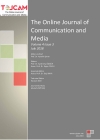TOJCAM - Volume 4 - Issue 2 - April 2018
 CELEBRITY ENDORSEMENT AND ITS IMPACT ON CONSUMER PERCEPTION: A STUDY OF GLOBACOM NIGERIA LIMITED
CELEBRITY ENDORSEMENT AND ITS IMPACT ON CONSUMER PERCEPTION: A STUDY OF GLOBACOM NIGERIA LIMITED Ayodeji O Awobamise, Yosra Jarrar
Abstract:
Celebrity endorsement usually involves a written or spoken statement by a public or sometimes private individual promoting the qualities of a particular brand or product. The telecommunication industry in Nigeria has witnessed very stiff competition since 2001 when the first set of GSM operators kicked off operation in the country. This competition has led to the folding up of a number of cellular Network providers in the country. With the growing competition, GSM operators in the country have since then been employing series of marketing communication tools to combat competition. One of which is celebrity endorsement. Globacom, one of the largest telecommunication companies in Nigeria has constantly employed celebrity endorsement and has used about 50 movie, music, football stars, media personalities and statesmen from inception. This study made use of Credibility Model and Source Attractiveness Model theories as a theoretical framework. The study made use of a combination of questionnaires and In-depth interviews to gather data; 200 questionnaires were distributed around Lagos, Nigeria and an interview was conducted with the head of Marketing of Globacom Nigeria. The findings of the research showed that although Celebrity endorsement is a good way to capture the attention of prospective customers, what actually makes these customers stay and what attracts the majority of the brand’s customers is not the celebrity but the quality of the product.
 COLORLESS PSYCHOLOGICAL EFFECTS
COLORLESS PSYCHOLOGICAL EFFECTS Canan DELİDUMAN, Çağrı Gümüş
Abstract:
Art is in a dynamic formation depending on the structure of society, age and region. The aesthetic sense of people carries traces of the cultural structure of the social circle that they are in together with their psychological behavior. When interpreted in terms of culture, aesthetics can also be considered variable. However, it is not the changing aesthetic principles but the aesthetic judgments of the society. The human eye, when perceiving a colored form, is affected by the surrounding colors and reflected light. They affect "depth" and "width" according to their color, chroma and tone values. They play a role in the pure, neat conditions of colors, far-near appearances of colors. Bright, light and vivid colors appear closer to the eye. Hot colors affect more area than cold ones. Vivid colors or cold colors are preferred according to age. Separate colors for babies are adopted according to gender differences of young children. The lightest hues of the colors have become indispensable preferences for babies and young children (for example, pink children's love for girls) because they express purity and cleanliness.
When investigating the effect of colors on humans, it is aimed to determine its significance in terms of reasons, impact ratios and artistic expression. This research, in which the effects of colors on humans in physical, chemical and artistic terms are explored, has been exploited by descriptive and experimental methods.
The red color that excites emotions. It directs young people because it provides orange movement and vitality. It attracts the attention of young people with cheerfulness and intelligence. Because they have different colors on different floors, they appear more lighted or without light. The colors of the artists most often used as a result of their acquisition characteristics or emotions vary depending on the periods. It has been found that the number of colors increases in comparison to the beginning of the year in Milano, the fact that many green colors are applied together due to the love of nature and that the relaxing side is effective in every period. It is certain that dark people symbolize dark, in other words, black, which is not counted as color in art.
 RESEARCH METHODS USED IN MEASUREMENT OF ADVERTISING EFFECTIVENESS AND COMPARATIVE STRENGTHS
RESEARCH METHODS USED IN MEASUREMENT OF ADVERTISING EFFECTIVENESS AND COMPARATIVE STRENGTHS Çağrı Gümüş
Abstract:
Nowadays, with increasing speed, the advertisements that are included in every field of our life are confronted in many forms both in printed media and in radio and television. These advertisements do not only make the target mass that they are talking about with the product or service, but they also have a significant influence on the decision of the target to receive the purchase. The fact that advertising plays an active role in buying behavior has led to businesses allocating large budgets for their promotions and thus becoming an industry by itself. The high level of impact that ads have on the target is an important aspect of the ad agency's ability to generate business-oriented ads as it is important for advertisers to anticipate the decisions they make about the ad they will make for the ad agency. There are a variety of research methods that measure the level of impact of the ad in terms of its purpose and the advertiser's expectations. By this study, it is aimed to give information about the research methods required to measure the effectiveness of an advertisement in various advertising media, to measure the advertising effects and to evaluate the difficulties encountered after these measures. The study was supported by an example made in this regard.
 SOCIAL NETWORKING SITES AND THE CONSTRUCTION OF DIGITAL SELFNESS 28
SOCIAL NETWORKING SITES AND THE CONSTRUCTION OF DIGITAL SELFNESS 28 Eda SEZERER ALBAYRAK
Abstract:
New communication technologies have become increasingly common in all areas of our daily lives. The transformation of interactive networks offered by information technologies has also affected many components of social life. While these technologies digitally exist as individuals, they also give them the freedom to relate to the digital self. Social networking networks can be considered as an expression of self with both the profiles they create and the shares they make. It is assumed that as individuals shape their digital self, they are influenced by the views of other users attached to their social network and are going to design an ego as a result of interaction. In the method part of the study, four cases belonging to the digital identity of a user actively using social networks are distributed in four groups and these four cases have been analyzed by different groups of individuals from different statu- rities formed within the framework of semi-structured interviews.
 TRANSMEDIA STORYTELLING AS THE NEW GENERATION STORYTELLING FORM ON MEDIA: “RAFADAN TAYFA” CASE STUDY
TRANSMEDIA STORYTELLING AS THE NEW GENERATION STORYTELLING FORM ON MEDIA: “RAFADAN TAYFA” CASE STUDY H. Deniz Karcı
Abstract:
This study has been conducted through a case study to show how transmedia storytelling, a new media storytelling way, is performed on Turkish media. Rafadan Tayfa story was reported as the case study after giving information about the principles of transmedia storytelling with some successful Hollywood and Turkish examples so that they stand for how transmedia projects have reached success. In this paper Rafadan Tayfa, a very popular fiction story among children and even parents, was studied to show what ways Turkish media uses to perform a transmedia project successfully. In the analysis part, all the platforms across which the story unfolds were analysed in detailed and with illustrations. It is seen that Turkish producers conducted Rafadan Tayfa transmedia project as both a marketing and social responsibility strategy, which makes the story a Turkish media brand.


